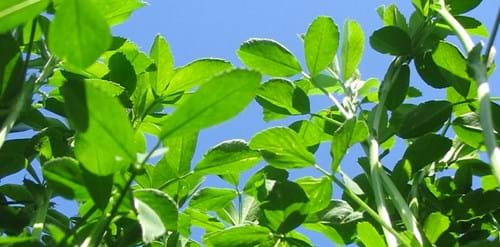Fall Alfalfa Stand Assessment Guidelines
BY SARA HAGEN, FORAGE LEADER
Fall is a great time to take a look at your alfalfa stands to help you know the current health status of your plants, the likelihood of winter survival, and preplan for Spring 2021 planting decisions.
First, take a look above the soil surface and determine the stand density. Measure an area of one square foot and count the number of plants (or the number of stems) within that square foot. Repeat this step four or five times throughout the field and calculate the average. If you have less than three or four plants, or less than 40 stems, it is time to rotate the stand. Pay attention to grass or weeds entering the stand as this is a good indicator that the stand will be less productive next year.
If your plant density numbers are adequate, the next place to investigate is below the soil surface. Using a small spade or shovel, dig several alfalfa plants out of the soil and remove the soil from around the roots. First, check the firmness of the crown. Pull the crown open and take a look at the inside of the crown and the upper part of the tap root. If the crown pulls apart easily or is soft, some deterioration has occurred and you need to look for other symptoms of disease or injury. If you see anything out of the ordinary, call your local agronomist to assist you in making a diagnosis.

Best Management Practices for Alfalfa in the Fall
- Take a look at your feed inventory before making the decision to take a fall harvest of alfalfa. If you need the feed, a fall harvest can yield over 1 ton of dry matter per acre. If you don’t need the feed, consider leaving the alfalfa stand to aid in gathering a snow cover.
- If you decide to take a fall cutting of alfalfa, wait until after the first frost or cut after the average date of the first frost in your area. It is important for winter survival that the alfalfa does not begin to regrow before going dormant for the winter.
- While taking your fall cutting of alfalfa, raise your cutter bar height to leave three to five inches of stubble. This will allow for a better
snow cover and also help allow oxygen to get to the stand in areas where ice sheeting occurs. - Small strips of alfalfa left standing in your field can also assist in snow cover and reduce the chances of winter injury.
- Be aware of the alfalfa dry matter that you removed over the course of the summer months and consider the fertilizer requirements
necessary to replenish the soil before or during next year’s growing season. - Perform an alfalfa stand assessment before applying fertilizer to ensure that your field has enough yield potential to justify extra input dollars.
